 Caribou Lake has some of the best fishing in Northern Ontario and is home to many species of fish. These species include Northern Pike, Walleye, Lake Trout, Sturgeon, White Fish, Perch, White Suckers, and various bait fish. Due to Caribou Lake being a colder lake and it's northern location there are no bass or pan fish. The most common species fished in Caribou Lake are Northern Pike, Walleye, and Lake Trout. Because of Caribou Lake's size and geography there are endless places to fish successfully and will draw you back year after year for pure fishing delite! We want you to know what to expect before you come to Caribou Lake and have given information below about Caribou Lake and how to successfully fish it.
Caribou Lake has some of the best fishing in Northern Ontario and is home to many species of fish. These species include Northern Pike, Walleye, Lake Trout, Sturgeon, White Fish, Perch, White Suckers, and various bait fish. Due to Caribou Lake being a colder lake and it's northern location there are no bass or pan fish. The most common species fished in Caribou Lake are Northern Pike, Walleye, and Lake Trout. Because of Caribou Lake's size and geography there are endless places to fish successfully and will draw you back year after year for pure fishing delite! We want you to know what to expect before you come to Caribou Lake and have given information below about Caribou Lake and how to successfully fish it.
About Caribou Lake
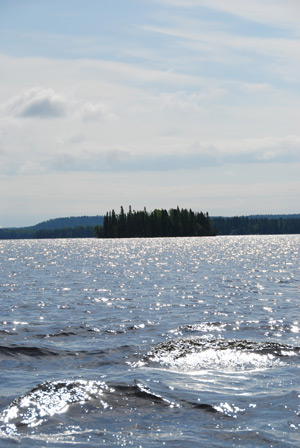 Caribou Lake is located near Ontario's Wabakimi Provincial Park and is over 40 KM (25 Miles) long and 23,000 acres in size. The deepest point is over 200 feet deep with many other "holes" reaching 60 or more feet deep. The geography of Caribou Lake is very dynamic, which is one of the reasons why the fishing is so good. In some spots, you can be trolling 10 feet from shore and the depth is over 30 or 50 feet deep. In other areas you can be boating in a wide open part of the lake and the depth can suddenly change to 2 feet or less. There are thousands of islands throughout Caribou Lake, which provide endless opportunities for excellent fishing. Northern Pike, Walleye, and Lake Trout are frequently caught around rocky shores and off of rocky points. In addition to Caribou Lake's many islands, there are also thousands of bays, river outlets, and river inlets. There are many smaller lakes that feed into Caribou Lake or that Caribou Lake feeds into. A large number of these lakes are a short portage or hike from where the inlet or outlet is located and provide good walleye and pike fishing. Shallow bays in Caribou Lake are known for being "hot spots" for large Northern Pike. Simply casting into these bays can sometimes yield 10 or more pike caught, with some over 3 feet in length.
Caribou Lake is located near Ontario's Wabakimi Provincial Park and is over 40 KM (25 Miles) long and 23,000 acres in size. The deepest point is over 200 feet deep with many other "holes" reaching 60 or more feet deep. The geography of Caribou Lake is very dynamic, which is one of the reasons why the fishing is so good. In some spots, you can be trolling 10 feet from shore and the depth is over 30 or 50 feet deep. In other areas you can be boating in a wide open part of the lake and the depth can suddenly change to 2 feet or less. There are thousands of islands throughout Caribou Lake, which provide endless opportunities for excellent fishing. Northern Pike, Walleye, and Lake Trout are frequently caught around rocky shores and off of rocky points. In addition to Caribou Lake's many islands, there are also thousands of bays, river outlets, and river inlets. There are many smaller lakes that feed into Caribou Lake or that Caribou Lake feeds into. A large number of these lakes are a short portage or hike from where the inlet or outlet is located and provide good walleye and pike fishing. Shallow bays in Caribou Lake are known for being "hot spots" for large Northern Pike. Simply casting into these bays can sometimes yield 10 or more pike caught, with some over 3 feet in length.
The Geography of Caribou Lake
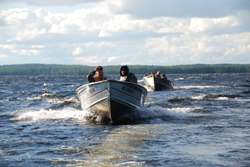 Caribou Lake can be separated into three distinct sections: The "Main" part, the Narrows, and "Up the Lake". When fishing on Caribou Lake great care is needed
Caribou Lake can be separated into three distinct sections: The "Main" part, the Narrows, and "Up the Lake". When fishing on Caribou Lake great care is needed
The "Main" Part
The main part of the lake is where all of the lodges and the landing are located and is largest open area of the lake. The Main part is about 5 miles long at it's longest point and about 3 miles wide at it's widest point. It also has the deepest point on the lake is the overall deepest part of the lake. Depths range from 20 - 60 feet on average. This part of the lake is excellent for Lake Trout fishing because it is generally colder and deeper. During storms waves of 4 - 6 feet are not uncommon, so please use caution when crossing the open water during rough weather.
The Narrows
The Narrows is the gateway between the two larger parts of the lake. It is generally shallow in the Narrows so caution is needed when boating through the Narrows. Fishing in this part of the lake can be quite good for walleyes and pike, especially earlier in the season and during the fall.
"Up the Lake"
The upper part of Caribou Lake holds the best and most areas to fish. There is an endless supply of winding channels, back bays, rocky shorelines, river inlets and outlets, and gorgeous scenery that will make your fishing experience the best you have ever had. It is simply impossible to see the whole lake in one week.
Important Information!
Caribou Lake is in the Canadian Shield which means that most of the area is very rocky. When boating around Caribou Lake use proper caution as rocks can be just under the surface and if hit, can cause damage to the boat and/or motor. Many of the dangerous rocks on well travelled areas are marked with buoys, but some are not. If you head up the lake further there are many places where unmarked rocks are just under the surface. Also, because Caribou Lake is so large and there are so many islands and back channels, it is very easy to get lost. Taking proper precautions can prevent you from getting lost and spending the night on the lake. Always bring extra gas as it is not uncommon to travel 20 or more miles in a day. Also, bringing a map (we can provide these at the lodge) and a hand held GPS can help you navigate your daily fishing excursions. It is also a good idea, if possible, to travel in groups of at least 2 boats and tell someone at camp where you are going.
How to Fish Caribou Lake
As we said earlier, Caribou Lake is home to many species of fish but Northern Pike, Walleye, and Lake Trout are the species that are most fished for. Factors such as time of year, time of day, water temperature, and weather need to be taken into consideration in order to have the best fishing possible. Below is a list of each of these three species of fish and how best to fish for them based on the above listed factors.
Northern Pike
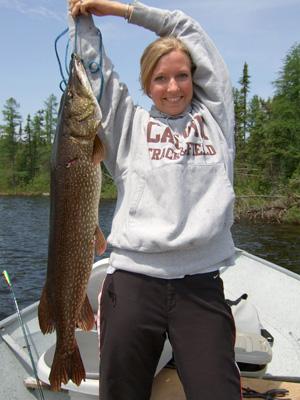 Northern Pike are probably the most consistent species, in terms of how to fish for them. Throughout the entire season their habitat and feeding habits remain mostly the same. Northern Pike like shallow bays, rocky shores, and river inlets and outlets, while avoiding deeper waters most of the time. Pike will frequently sun bath in shallow bays and can often be seen swimming along the bottom in shallow areas. Pike are vicious carnivores that have a large appetite and an attitude to match. Pike are one of the only fish that strike an object purely because it makes them angry. This is good news for anglers though, because using flashy spoons and baits are a sure fire way to pull in a big pike. Of all of the fish in Caribou Lake, pike are probably the most fun to fish for because they are larger and provide a better fight. If a pike follows your bait as you reel it in, you can simply put the bait back in the water right next to the boat and jig it around to coax the pike into striking the lure again. Sometimes a pike will strike a lure 2, 3, or even 5 or 6 times right next to the boat! The use of steel leaders is highly recommended when fishing for pike as they have a tendancy to inhale lures and have hundreds of razor sharp teeth. Northern Pike, expecially large ones, are often caught while fishing for walleyes. Pike will hang out where the walleyes are and feed on the them. It is not uncommon to catch a walleye and while reeling it in feel a light tug and then notice that your walleye just got harder to reel in. This happens when a pike tries to eat the walleye that you have just caught, and usually the pike is over 36 or 40 inches long. Sometimes anglers are able to catch the pike and the walleye by netting both, but frequently the pike will let go of the walleye after coming to the surface a couple times. Pike are not known for being shy and during this past summer (2008), one of our groups caught a 44 inch northern pike that tried to eat a walleye on their stringer!
Northern Pike are probably the most consistent species, in terms of how to fish for them. Throughout the entire season their habitat and feeding habits remain mostly the same. Northern Pike like shallow bays, rocky shores, and river inlets and outlets, while avoiding deeper waters most of the time. Pike will frequently sun bath in shallow bays and can often be seen swimming along the bottom in shallow areas. Pike are vicious carnivores that have a large appetite and an attitude to match. Pike are one of the only fish that strike an object purely because it makes them angry. This is good news for anglers though, because using flashy spoons and baits are a sure fire way to pull in a big pike. Of all of the fish in Caribou Lake, pike are probably the most fun to fish for because they are larger and provide a better fight. If a pike follows your bait as you reel it in, you can simply put the bait back in the water right next to the boat and jig it around to coax the pike into striking the lure again. Sometimes a pike will strike a lure 2, 3, or even 5 or 6 times right next to the boat! The use of steel leaders is highly recommended when fishing for pike as they have a tendancy to inhale lures and have hundreds of razor sharp teeth. Northern Pike, expecially large ones, are often caught while fishing for walleyes. Pike will hang out where the walleyes are and feed on the them. It is not uncommon to catch a walleye and while reeling it in feel a light tug and then notice that your walleye just got harder to reel in. This happens when a pike tries to eat the walleye that you have just caught, and usually the pike is over 36 or 40 inches long. Sometimes anglers are able to catch the pike and the walleye by netting both, but frequently the pike will let go of the walleye after coming to the surface a couple times. Pike are not known for being shy and during this past summer (2008), one of our groups caught a 44 inch northern pike that tried to eat a walleye on their stringer!
Baits to use: Large Spoons, Daredevils, Large Minnow Lures, Flashy Lures in Genereal
Walleye
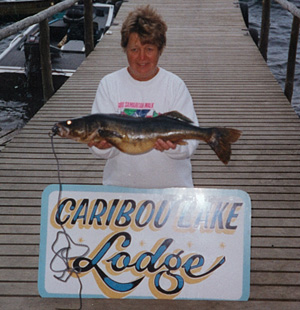 Fishing for Walleyes in Caribou Lake is more about understanding their habits and characteristics than anything else. Many factors come in to play when fishing for walleyes including weather, air and water temperature, depth, and time of year. Early in the season (May and June), walleyes tend to gather in shallower bays for feeding and spawning. After they have spawned and the water gets warmer, they will head to deeper water. Late spring, early summer, and fall is when the walleyes are in shallow water. Mid July through mid September is when the walleyes are located in deeper waters. While they are in shallower areas they can be fished for in as little as 5 - 8 feet of water by simply trolling with a minnow lure. When they go to deeper water, jigging with live bait is the best means of catching them. Walleyes tend not feed during the "heat" of the day. On sunny days, they will feed primarily in the morning and in the evening, while remaining inactive during the afternoon. During overcast days, walleyes will feed more consistently throughout the entire day. If a storm comes in and a day turns from sunny to stormy, walleyes generally will begin feeding as the overcast weather and rain come in. Sometimes they will begin feeding in a frenzy like fashion as if someone just flipped a switch. After large storms though, sometimes walleye activity will be low until the weather changes.
Fishing for Walleyes in Caribou Lake is more about understanding their habits and characteristics than anything else. Many factors come in to play when fishing for walleyes including weather, air and water temperature, depth, and time of year. Early in the season (May and June), walleyes tend to gather in shallower bays for feeding and spawning. After they have spawned and the water gets warmer, they will head to deeper water. Late spring, early summer, and fall is when the walleyes are in shallow water. Mid July through mid September is when the walleyes are located in deeper waters. While they are in shallower areas they can be fished for in as little as 5 - 8 feet of water by simply trolling with a minnow lure. When they go to deeper water, jigging with live bait is the best means of catching them. Walleyes tend not feed during the "heat" of the day. On sunny days, they will feed primarily in the morning and in the evening, while remaining inactive during the afternoon. During overcast days, walleyes will feed more consistently throughout the entire day. If a storm comes in and a day turns from sunny to stormy, walleyes generally will begin feeding as the overcast weather and rain come in. Sometimes they will begin feeding in a frenzy like fashion as if someone just flipped a switch. After large storms though, sometimes walleye activity will be low until the weather changes.
Baits to use: Minnow Lures, Jigs, Live Minnows, Crawler Harnesses, Live Leaches
Lake Trout
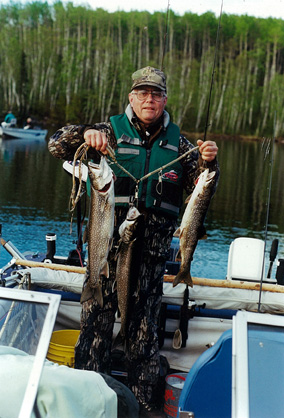 People that fish for Lake Trout in the Great Lakes regions often refer to them as "greasers" because they tend to soak up oils and toxins from the environment inwhich they live. For this reason, Lake Trout in Caribou Lake are always fresh and free of oils and toxins due to the purity of Caribou Lake. Lake Trout are excellent to eat and can be cooked in a variety of ways from broiling to smoking to pan fying. Lake Trout prefer colder water and follow a fairly predictable pattern as the season progresses. During the months of May and June while the water is still cold at the surface, Lake Trout can be caught within 10 - 15 feet of the surface. As the water warms, Lake Trout will go deeper until the use of down riggers is necessary to adequently fish for them.
People that fish for Lake Trout in the Great Lakes regions often refer to them as "greasers" because they tend to soak up oils and toxins from the environment inwhich they live. For this reason, Lake Trout in Caribou Lake are always fresh and free of oils and toxins due to the purity of Caribou Lake. Lake Trout are excellent to eat and can be cooked in a variety of ways from broiling to smoking to pan fying. Lake Trout prefer colder water and follow a fairly predictable pattern as the season progresses. During the months of May and June while the water is still cold at the surface, Lake Trout can be caught within 10 - 15 feet of the surface. As the water warms, Lake Trout will go deeper until the use of down riggers is necessary to adequently fish for them.
Baits to use: Trout spoons, Little Cleos, silver minnow lures, and live minnows
Please feel free to Contact Us about rates and reservations.
